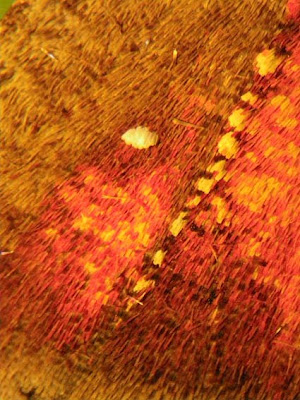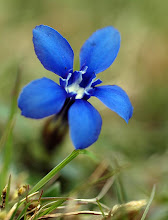I found this delightful little harvestman amongst some raspberries that I picked yesterday evening. Although they are carnivores, they do seem to have a liking for ripe fruit.
Despite their spider-like appearance and the fact that they belong to the Arachnids, harvestmen are not true spiders but belong to an order of their own known as the Opiliones, distingished from spiders by their globular bodies, unlike those of true spiders which are divided into two parts - the separate thorax and abdomen, separated by a constriction. Harvestmen always seem to have an other-worldly appearance and, scaled up to monstrous proportions, wouldn't be out of place in a science fiction movie. Many of their sensory functions are located in their legs and if you watch the way in which they use these - particularly the second pair that are often far longer than the others - it's quite clear that they are using them to feel and taste their way around their habitat. Nevertheless, when danger threatens they can shed a leg (autotomy) and leave it twitching on the ground, to deflect the attention of a predator. Unlike true spiders, they can't regrow limbs after moulting, so this desperate measure leaves them short of a limb and sensorily deprived. Before they resort to limb-shedding, they often exude an unpleasant-smelling liquid from their leg joints which you can smell if you hold an irritated harvestman in your hand. This isn't an infallible deterrent - I've watched robins feeding their brood with harvestmen.
One of the most remarkable features of harvestmen is the arrangement of their eyes, in a kind of turret called an ocularium, high up on their back. This arrangement makes sense when you get down to a harvestman's eye-level ...
... when it's clear this this gives it 360 degree vision around and above its globular body....
..... although one can only guess at how much detail those unblinking black eyes resolve.
Nevertheless, whatever angle you approach from a harvestman always has it covered........one of those eyes always seems to have you in its sights...
There's an excellent little booklet called British Harvestmen by J.H.P. Sankey and T.H.Savory (Synopses of the British Fauna (New Series) No. 4 ISBN 0 12 619050) that not only provides fascinating detail about their biology but also contains some delightful little anecdotes. For example, some species apparently kill their prey by positioning their globular bodies over their victim that's imprisoned by their legs and then bouncing up and down on those long legs, 'pile-driving' the unfortunate prey. Others have been noted for a prediliction for marmalade sandwiches from a picnic and on one occasion ink from ink wells (although this one refused black ink and would only drink the red stuff).
I haven't got around to identifying the species of this individual yet and if there's anyone out there who can help me out, I'd be grateful....


































